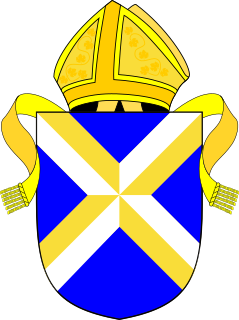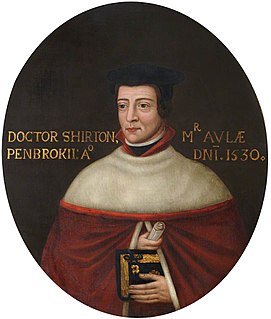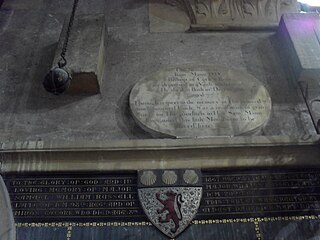
Bath Abbey is a parish church of the Church of England and former Benedictine monastery in Bath, Somerset, England. Founded in the 7th century, it was reorganised in the 10th century and rebuilt in the 12th and 16th centuries; major restoration work was carried out by Sir George Gilbert Scott in the 1860s. It is one of the largest examples of Perpendicular Gothic architecture in the West Country. The medieval abbey church served as a sometime cathedral of a bishop. After long contention between churchmen in Bath and Wells the seat of the Diocese of Bath and Wells was later consolidated at Wells Cathedral. The Benedictine community was dissolved in 1539 during the Dissolution of the Monasteries.
Walter Giffard was Lord Chancellor of England and Archbishop of York.

George Anthony Denison (1805–1896) was an English Anglican priest. He served as Archdeacon of Taunton from 1851.

The Bishop of Bath and Wells heads the Church of England Diocese of Bath and Wells in the Province of Canterbury in England.
Savaric fitzGeldewin was an Englishman who became Bishop of Bath and Glastonbury in England. Related to his predecessor as well as to Emperor Henry VI, he was elected bishop on the insistence of his predecessor, who urged his election on the cathedral chapter of Bath. While bishop, Savaric spent many years attempting to annexe Glastonbury Abbey as part of his bishopric. Savaric also worked to secure the release of King Richard I of England from captivity, when the king was held by Emperor Henry VI.

Charles Moss was an Anglican clergyman who served as Bishop of St David's from 1766 to 1774 and Bishop of Bath and Wells from 1774 to 1802.
John of Tours or John de Villula (died 1122) was a medieval Bishop of Wells in England who moved the diocese seat to Bath. He was a native of Tours and was King William I of England's doctor before becoming a bishop. After his consecration as bishop, he was either given or purchased Bath Abbey, a rich monastery, and then moved the headquarters of the diocese from Wells, to the abbey. He rebuilt the church at Bath, building a large cathedral that no longer survives. He gave a large library to his cathedral and received the right to hold a fair in Bath. Not noted for his scholarship, he died suddenly in 1122.
William of Bitton was a medieval English Bishop of Bath and Wells.
William of Bitton was a medieval Bishop of Bath and Wells.
Nicholas Bubwith (1355-1424) was a Bishop of London, Bishop of Salisbury and Bishop of Bath and Wells as well as Lord Privy Seal and Lord High Treasurer of England.
Robert de Chauncy was a medieval Bishop of Carlisle.

Robert John Eden, 3rd Baron Auckland, styled The Honourable Robert Eden from birth until 1849, was a British clergyman. He was Bishop of Sodor and Man from 1847 to 1854 and Bishop of Bath and Wells from 1854 to 1869.

Richard Beadon was Master of Jesus College, Cambridge 1781–1789 and later Vice-Chancellor of the University, Bishop of Gloucester and Bishop of Bath and Wells.

Robert Shorton was an English churchman and academic, first Master of St John's College, Cambridge and Archdeacon of Bath.
The Archdeacon of Bath is a senior ecclesiastical officer in the Church of England Diocese of Bath and Wells. The post, having oversight over the archdeaconry of Bath, has existed since the twelfth century. The archdeaconry includes five deaneries.
William Thomas Parr Brymer was Archdeacon of Bath from his installation on 1 April 1840 until his death on 19 August 1852.

Isaac Mann was Church of Ireland Bishop of Cork and Ross from 1772 to 1788.
This page is based on this
Wikipedia article Text is available under the
CC BY-SA 4.0 license; additional terms may apply.
Images, videos and audio are available under their respective licenses.







